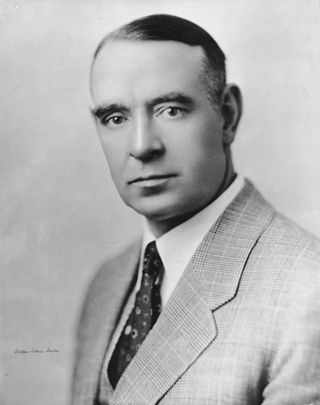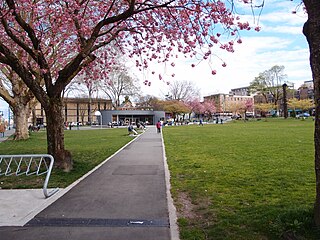
The On-to-Ottawa Trek was a mass protest movement in Canada in 1935 sparked by unrest among unemployed single men in federal relief camps principally in Western Canada. Federal relief camps were brought in under Prime Minister R. B. Bennett’s government as a result of the Great Depression. The Great Depression crippled the Canadian economy and left one in nine citizens on relief. The relief, however, did not come free; the Bennett government ordered the Department of National Defence to organize work camps where single unemployed men were used to construct roads and other public works at a rate of twenty cents per day. The men in the relief camps were living in poor conditions with very low wages. The men decided to unite in 1933, led by Arthur "Slim" Evans, an officer of the Workers' Unity League (WUL). The Workers' Unity League helped the men organize the Relief Camp Workers' Union.

The worldwide Great Depression of the early 1930s was a social and economic shock that left millions of Canadians unemployed, hungry and often homeless. Few countries were affected as severely as Canada during what became known as the "Dirty Thirties", due to Canada's heavy dependence on raw material and farm exports, combined with a crippling Prairies drought known as the Dust Bowl. Widespread losses of jobs and savings ultimately transformed the country by triggering the birth of social welfare, a variety of populist political movements, and a more activist role for government in the economy.

Gerald Grattan McGeer was a lawyer, populist politician, and monetary reform advocate in the Canadian province of British Columbia. He served as the 22nd Mayor of Vancouver, a Member of the Legislative Assembly in BC, Member of Parliament for the Liberal Party of Canada, and in the Canadian Senate.

The Vancouver Police Department (VPD) is the police force in Vancouver, British Columbia, Canada. It is one of several police departments within the Metro Vancouver Area and is the second largest police force in the province after RCMP "E" Division.
Harold Edward Winch was a Canadian politician active with the Co-operative Commonwealth Federation (CCF) and its successor, the New Democratic Party (NDP).

The Workers' Unity League (WUL) was established in January 1930 as a militant industrial union labour central closely related to the Communist Party of Canada on the instructions of the Communist International.

Oppenheimer Park is a park located in the historic Japantown (Paueru-Gai) in the Downtown Eastside, Vancouver, British Columbia, Canada.

Major-General William Wasbrough Foster, CMG, DSO, VD was a noted mountaineer, Conservative Party politician, businessman, and chief constable in British Columbia, Canada, in addition to his distinguished military career.
The Battle of Ballantyne Pier occurred in Ballantyne Pier during a docker's strike in Vancouver, British Columbia, in June 1935.

Relief Camp Workers' Union was a Canadian Great Depression era relief union in which the workers employed in the Canadian government relief camps organized themselves into in the early 1930s. The RCWU was established by the Workers' Unity League and was associated with the Communist Party of Canada. The creation of the union was a direct response to the conditions of the camps and the lack of financial compensation for the work the men provided. The union is best known for helping to organize the On-to-Ottawa Trek during the Great Depression.

Arthur Herbert "Slim" Evans was a leader in the industrial labor union movement in Canada and the United States. He is most known for leading the On To Ottawa Trek. Evans was involved in the Industrial Workers of the World, the One Big Union, and the Worker's Unity League. He was a member of the Communist Party of Canada.

The British Columbia Maritime Employers Association is an association representing the interests of member companies in industrial relations on Vancouver's and other British Columbian seaports.

Angelo Branca was a judge in British Columbia's Supreme Court and Court of Appeal from 1963 until 1978, a prominent Italian-Canadian leader, especially of the Vancouver Italian community, and a Canadian amateur middleweight boxing champion.
Jamie Graham, O.O.M. is a former chief for the Victoria Police Department. He previously served as the chief constable of Vancouver, British Columbia from August 22, 2002 to August 13, 2007. A former Royal Canadian Mounted Police officer, Graham's five-year contract with the Vancouver Police Department was not renewed. His time as chief there ended on August 22, 2007.

The Pressed Steel Car strike of 1909, also known as the 1909 McKees Rocks strike, was an American labor strike which lasted from July 13 through September 8. The walkout drew national attention when it climaxed on Sunday August 22 in a bloody battle between strikers, private security agents, and the Pennsylvania State Police. At least 12 people died, and perhaps as many as 26. The strike was the largest and most significant industrial labor dispute in the Pittsburgh area since the famous 1892 Homestead strike and was a precursor to the Great Steel Strike of 1919.
Vancouver riot may refer to any of several riots in Vancouver, British Columbia, Canada, including:

The Coastal GasLink pipeline is a TC Energy natural gas pipeline under construction in British Columbia, Canada. Starting in Dawson Creek, the pipeline's route crosses through the Canadian Rockies and other mountain ranges to Kitimat, where the gas will be exported to Asian customers. Its route passes through several First Nations peoples' traditional lands, including some that are unceded. Controversy around the project has highlighted important divisions within the leadership structure of impacted First Nations: elected band councils established by the 1876 Indian Act support the project, but traditional hereditary chiefs of the Wetʼsuwetʼen people oppose the project on ecological grounds and organized blockades to obstruct construction on their traditional land.
The Housing Protests on the South Side of Chicago in August 1931 began as a clash between white police and African Americans over the eviction of Diana Gross, a seventy-two year old black woman. Police were sent to enforce the eviction and encountered direct conflict with the crowd that had assembled and who were attempting to place her furniture back inside her home. The ensuing confrontation between police and the protesters led to the shooting deaths of two black men during the event, one black man killed later in the aftermath, as well as several injuries to policemen.
Bloody Sunday may refer to:

















